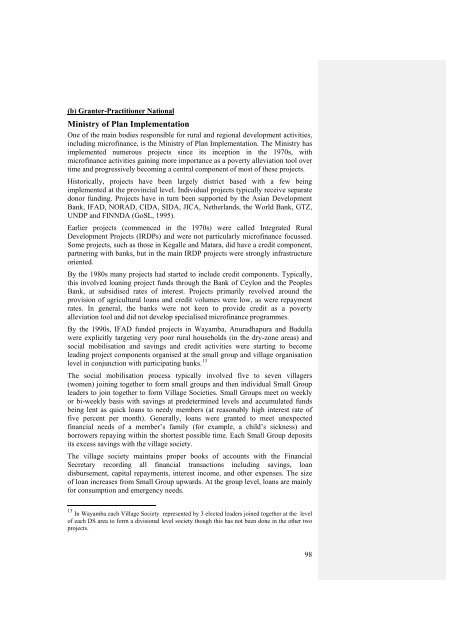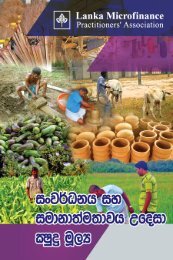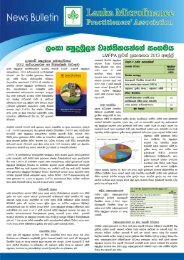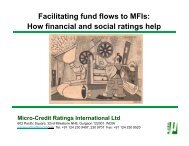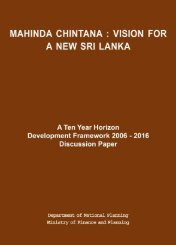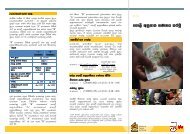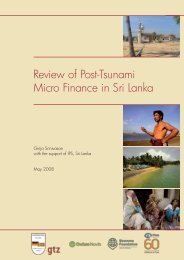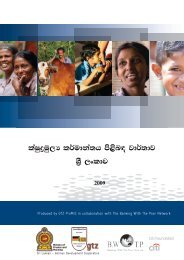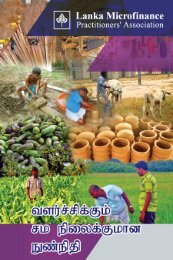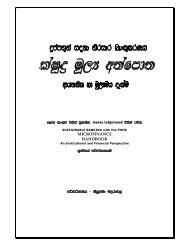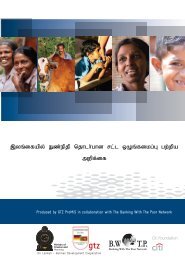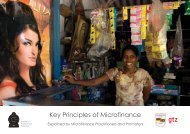National Microfinance Study of Sri Lanka: Survey of Practices and ...
National Microfinance Study of Sri Lanka: Survey of Practices and ...
National Microfinance Study of Sri Lanka: Survey of Practices and ...
You also want an ePaper? Increase the reach of your titles
YUMPU automatically turns print PDFs into web optimized ePapers that Google loves.
(b) Granter-Practitioner <strong>National</strong><br />
Ministry <strong>of</strong> Plan Implementation<br />
One <strong>of</strong> the main bodies responsible for rural <strong>and</strong> regional development activities,<br />
including micr<strong>of</strong>inance, is the Ministry <strong>of</strong> Plan Implementation. The Ministry has<br />
implemented numerous projects since its inception in the 1970s, with<br />
micr<strong>of</strong>inance activities gaining more importance as a poverty alleviation tool over<br />
time <strong>and</strong> progressively becoming a central component <strong>of</strong> most <strong>of</strong> these projects.<br />
Historically, projects have been largely district based with a few being<br />
implemented at the provincial level. Individual projects typically receive separate<br />
donor funding. Projects have in turn been supported by the Asian Development<br />
Bank, IFAD, NORAD, CIDA, SIDA, JICA, Netherl<strong>and</strong>s, the World Bank, GTZ,<br />
UNDP <strong>and</strong> FINNDA (GoSL, 1995).<br />
Earlier projects (commenced in the 1970s) were called Integrated Rural<br />
Development Projects (IRDPs) <strong>and</strong> were not particularly micr<strong>of</strong>inance focussed.<br />
Some projects, such as those in Kegalle <strong>and</strong> Matara, did have a credit component,<br />
partnering with banks, but in the main IRDP projects were strongly infrastructure<br />
oriented.<br />
By the 1980s many projects had started to include credit components. Typically,<br />
this involved loaning project funds through the Bank <strong>of</strong> Ceylon <strong>and</strong> the Peoples<br />
Bank, at subsidised rates <strong>of</strong> interest. Projects primarily revolved around the<br />
provision <strong>of</strong> agricultural loans <strong>and</strong> credit volumes were low, as were repayment<br />
rates. In general, the banks were not keen to provide credit as a poverty<br />
alleviation tool <strong>and</strong> did not develop specialised micr<strong>of</strong>inance programmes.<br />
By the 1990s, IFAD funded projects in Wayamba, Anuradhapura <strong>and</strong> Badulla<br />
were explicitly targeting very poor rural households (in the dry-zone areas) <strong>and</strong><br />
social mobilisation <strong>and</strong> savings <strong>and</strong> credit activities were starting to become<br />
leading project components organised at the small group <strong>and</strong> village organisation<br />
level in conjunction with participating banks. 13<br />
The social mobilisation process typically involved five to seven villagers<br />
(women) joining together to form small groups <strong>and</strong> then individual Small Group<br />
leaders to join together to form Village Societies. Small Groups meet on weekly<br />
or bi-weekly basis with savings at predetermined levels <strong>and</strong> accumulated funds<br />
being lent as quick loans to needy members (at reasonably high interest rate <strong>of</strong><br />
five percent per month). Generally, loans were granted to meet unexpected<br />
financial needs <strong>of</strong> a member’s family (for example, a child’s sickness) <strong>and</strong><br />
borrowers repaying within the shortest possible time. Each Small Group deposits<br />
its excess savings with the village society.<br />
The village society maintains proper books <strong>of</strong> accounts with the Financial<br />
Secretary recording all financial transactions including savings, loan<br />
disbursement, capital repayments, interest income, <strong>and</strong> other expenses. The size<br />
<strong>of</strong> loan increases from Small Group upwards. At the group level, loans are mainly<br />
for consumption <strong>and</strong> emergency needs.<br />
13 In Wayamba each Village Society represented by 3 elected leaders joined together at the level<br />
<strong>of</strong> each DS area to form a divisional level society though this has not been done in the other two<br />
projects.<br />
98


